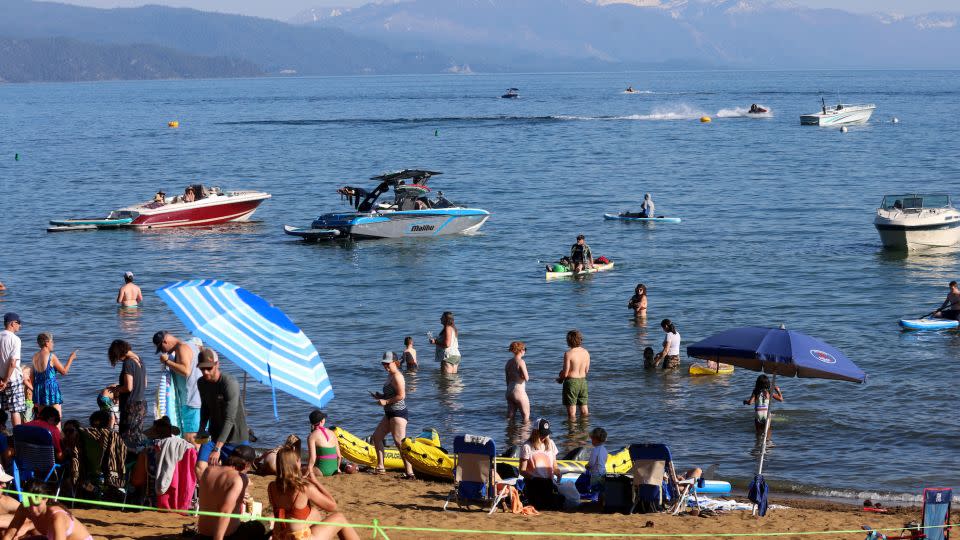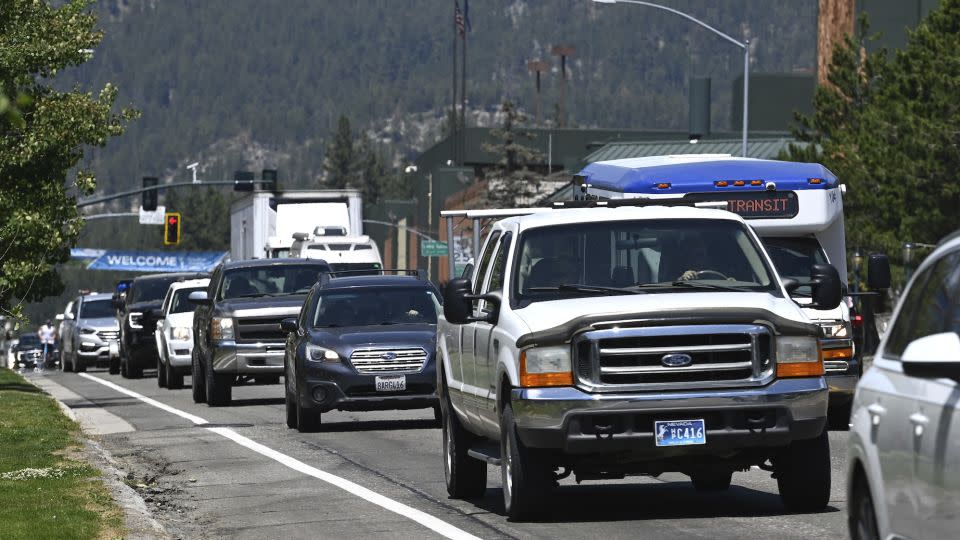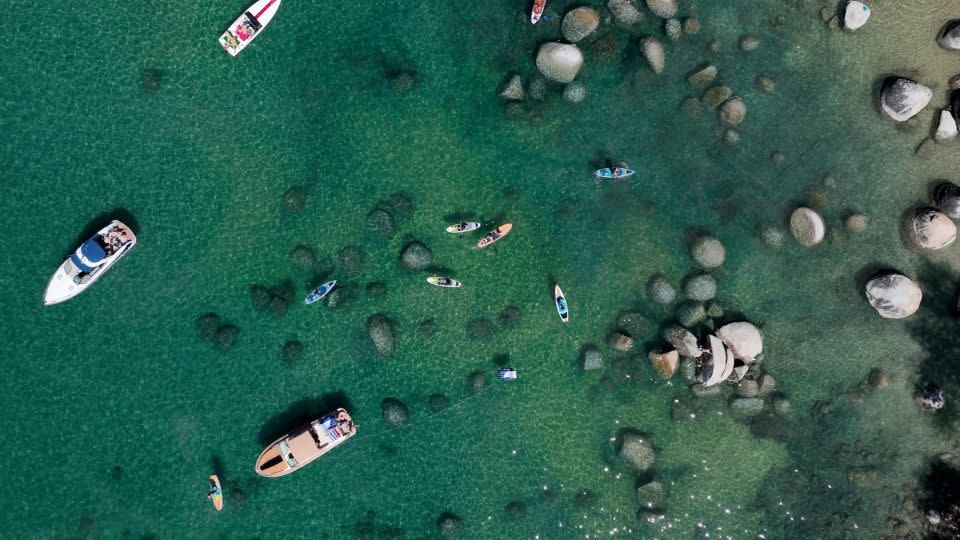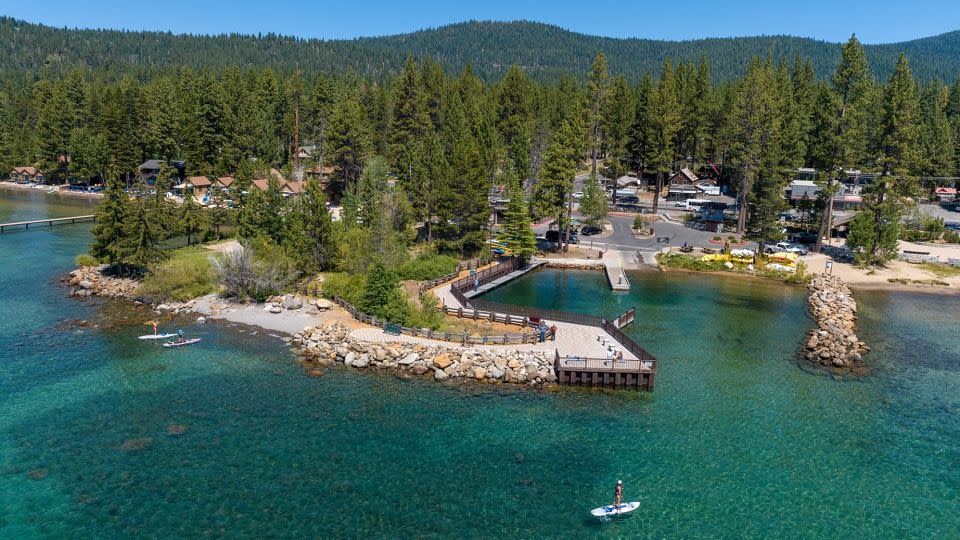The monster that feeds and eats away at Lake Tahoe
On a busy late July weekday at the beach in Incline Village, Nevada, on the north shore of Lake Tahoe, swimmers dip in and out of the frigid sapphire water while a kids’ summer camp wraps up for the day. The 20-something counselor belts out an order to his mini squadron.
“First one to pick up all their trash and put it in the bins wins!”
The children giggle and scurry across the coarse sand, scooping up sandwich bags and other lunchbox remnants. Within minutes, all that remains are indents from their tiny feet.
The scene is a far cry from what happened on July 4 at Zephyr Shoals, another popular Lake Tahoe beach 16 miles south, where holiday revelers left more than 6,000 pounds of trash, plastic, clothing, toys, and other miscellaneous junk.
Videos of the litter-fest went viral on social media and made international news, sparking outrage and calls for change by everyone from residents to environmental watchdogs. But the blatant disregard for Lake Tahoe’s natural beauty is just another incident in a string of many over the years that have prompted tourism officials and environmentalists to rethink just what type of visitor Lake Tahoe should court.
“A lot of what we find around Lake Tahoe is accidental. Something blew overboard or fell out of a backpack. But Zephyr Shoals was 100% intentional,” said Colin West, founder of Clean up the Lake. The nonprofit has been a key player in some of the lake’s most ambitious clean-up efforts, including one that pulled in more than 25,000 pounds of litter and debris during a 72-mile circumnavigation of Lake Tahoe’s shoreline between May 2021-22.
An estimated 15 million people travel to the Lake Tahoe area each year to enjoy the water sports and beaches, scenic vistas and mountain trails, and world-class ski resorts. To put those figures into perspective, Yosemite National Park has about 3.5 million visitors annually and is three times the size.
The duality of Lake Tahoe’s tourism conundrum is real: the economic monster that feeds the region is the same one that’s gnawing away at its existence. It’s a problem tourism organizations, environmental nonprofits, and residents are all eager to solve.
Mindset shift
Overtourism isn’t unique to Lake Tahoe and, like everywhere, its consequences have manifested into more than just piled-up trash. Traffic, car pollution, illegal parking, microplastics, and a severe lack of affordable housing (which equates to massive staffing shortages) have steadily suffocated the quality of life, character, and fragile ecosystem of the pristine Sierra Nevada playground. So much so that the long-established goal of regional tourism boards has shifted drastically, from attracting visitors to educating them.

“The value of tourism needs to be reiterated,” says Carol Chaplin, president and CEO of Lake Tahoe Visitors Authority (LTVA). “But the industry needs to work harder on behalf of the destination and environmental stewardship, and our tourism economy needs to work on behalf of our communities. The why, how, and when you visit Lake Tahoe has become our focus.”
In June, an unprecedented consortium of Lake Tahoe Destination Marketing Organizations, land management, and non-profit organizations signed the Lake Tahoe Destination Stewardship Plan. The 143-page plan is one of the most comprehensive to date and addresses the critical challenges facing the region via a shared vision for managing recreation and tourism.
Kirstin Guinn, marketing director of North Tahoe Community Alliance, echoed Chaplin’s sentiments. “We are not a traditional tourism board any longer, but welcome visitors to our community who understand and participate in environmental stewardship. This has been a huge transition for our organization.”
Love ‘em or leave ‘em?
One afternoon in July on the two-lane road circling the lake, cars pull over to snap pictures of the sparkling view. A white pickup truck, presumably Forestry Services or highway patrol, rolls by and a bullhorn announcement pierces the air: “You are all illegally parked. I advise you not to be here when I come back.”
The message leans on the polite side, but the resentment fueling the announcement is palpable. The sheer volume of visitors has taken its toll on Lake Tahoe’s fragile ecosystems as well as the nerves of the region’s roughly 71,000 full-time residents, giving rise to calls for visitor numbers to be restricted. It’s a suggestion Chaplin says would be almost impossible to implement in an area that isn’t a designated national park, has multiple roads in and out, and spreads across five counties and two states.
Yet despite boiling frustrations, many residents caution against adopting an anti-tourist attitude, including Alenka Vrecek, who worked as a ski instructor and coach at Palisades (formerly Squaw Valley) for 30 years.

“The truth is that none of us would be here without them [tourists],” Vrecek says. “We rely on them for our livelihoods. Yes, traffic is annoying, and no one wants to see litter in their backyard. But the question shouldn’t be ‘How can we limit tourism?’ but rather ‘How can we manage it for a better future for Lake Tahoe?’”
Like in many places around the world facing similar onslaughts, finding this equilibrium is essential, but solutions aren’t simple or quick. But what has become a unified rallying cry of tourism, including in Lake Tahoe, is responsibility.
Quality over quantity
South Lake Tahoe resident Jenay Aiksnoras has lived in the area since 2008 and says it’s not uncommon for her to ask visitors to properly dispose of their litter, guide them to dog-friendly beaches, or offer advice on why it’s not okay to feed the wildlife. Some people ignore her, she says, but a lot listen and say, ‘I didn’t know.’ In 2021, Aiksnoras founded Bliss Experiences, whose outdoor excursions are also informative.
“When I take people out to do paddle yoga, I see it as an opportunity to share information about the lake and its clean and drinkable water, or how microplastics in the water come from litter,” says Aiksnoras. “My hope is they take this mindset home with them and to other places too. That’s how I like to travel — with respect for the local communities and environment I am visiting.”
The ultimate goal of Lake Tahoe residents and officials is a framework that attracts people who care about the environment and embrace a pervasive leave-no-trace ethos, a tourism profile that’s on the rise, according to a 2022 Booking.com Sustainable Travel Report.
Of the more than 30,000 travelers across 32 countries and territories polled, more than 80% claim sustainability is important to them. The research also indicated an increase in the readiness of travelers to take personal responsibility for their own behavior, a visitor trait local organizations can get behind.
“We believe that people want to do the right thing when they know what the right thing is,” says Guinn. “That is the heart of stewardship, and it applies to everyone, not just visitors.”
Purpose-fueled fun
In mid-August, West and Clean Up The Lake opened a first-of-its-kind Environmental Dive Center (EDC) in Incline Village. Part conservation dive school and part environmental science educational hub, the center will offer dive certifications to residents and visitors and serve as a community space for youth and school groups, aquatic invasive species training, environmental film screenings, and other seminars on how to protect Lake Tahoe.

“What we want to create is an opportunity to approach a visit to Lake Tahoe in a different way,” says West. “We want to build a culture of conservation that centers around purpose-fueled fun.”
Dovetailing on the idea, Chaplin says she’d like people, organizations, and even the area’s large resorts to commit to encouraging guests to treat a place with respect, which means eliminating single-use plastic and promoting the use of the area’s year-round free public transport systems (TART and Lake Link), rather than driving.
“I also hope that when people come in and want to do something to help, like clean up a trail or a beach, that we see more of that behavior go viral on social media rather than just the bad stuff,” she says. “That will also go a long way to reinforce the type of tourism we want to celebrate.”
Meanwhile, the North Tahoe Public Utility District just cut the ribbon on the Tahoe Vista Recreation Area marina trail and scenic overlook, which helps mitigate the shore erosion that directly affects lake clarity while improving ADA accessibility and infrastructure for all residents and visitors.
“This is a great example of where Lake Tahoe is going,” said Guinn, who also pointed to decisions to switch from hazardous fireworks to drones for 4th of July celebrations, and the placement of volunteer Lake Tahoe Ambassadors at popular recreation sites to provide information to visitors about trail and wildlife etiquette as well as proper trash disposal and other leave-no-trace principles.

Keep Tahoe Blue
Known by its slogan “Keep Tahoe Blue,” the League to Save Lake Tahoe, founded in 1957, is Lake Tahoe’s oldest and largest nonprofit environmental advocacy group. The group has led a July 5th beach clean for the last 10 years, among other hands-on-the-ground events.
Still, the organization’s chief strategy officer, Jesse Patterson, said this year’s 4th of July was one of the worst he’s seen – and a wake-up call.
“What gives me hope is that everyone I meet loves this place and can’t imagine losing it,” he says. “This reaffirms what we all believe and want tourists to know: that if you’re going to come and enjoy Lake Tahoe then you need to protect it too.”
According to Patterson, thousands of volunteer visitors and residents come out each year to join a clean-up crew or report findings through the Citizen Science Tahoe app.
One volunteer, Nathan Quintal, a UPS employee from Lodi, California, about 130 miles southwest of Lake Tahoe, has done everything from picking up roadside trash to collecting water samples. This July, the 28-year-old was part of a crew that collected around 23 pounds of plastic bottles, food containers, and even illegal fire rings from around Emerald Bay.
Quintal isn’t a resident but has fond childhood memories of visiting Lake Tahoe with his parents and is fearful that future generations won’t get to experience its beauty.
“I have seen the videos. I have seen the pictures of what overtourism has done to other places, and I don’t want that to happen to Tahoe,” he says. “I feel like the least I can do is give my time to protect a place that I love.”
Kimberley Lovato is a California-based freelance writer.
Correction: A previous version of this story misspelled Kirstin Guinn’s first name.
Editor’s Note: Call to Earth is a CNN editorial series committed to reporting on the environmental challenges facing our planet, together with the solutions. Rolex’s Perpetual Planet initiative has partnered with CNN to drive awareness and education around key sustainability issues and to inspire positive action.
For more CNN news and newsletters create an account at CNN.com
